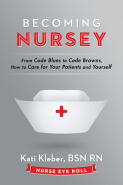
iStock | sumroeng
Since my post entitled I Wish I Could Cry With You, But I Can’t went up, a LOT of people have commented!
I felt the need to write a follow-up post to further explain myself. I think that a lot of nurses really understood what I meant with my post, but those who either aren’t nurses or haven’t been in the field long thought that me not crying meant I’m not there for my patients and I ignore their emotional needs.
You see, there is quite a vast amount of gray space between being emotionally void and jumping all the way in.
I described a grieving patient or family member as being a deep, dark pit of despair. I talked about me empathizing with them by climbing down a ladder into that pit with them, but needing to stay on that last step so that I can quickly climb out for my patient next door at the drop of a hat.
I got that example from the wonderful Brené Brown. Here’s this phenomenal explanation of the difference between being sympathetic and empathetic: Sympathy vs. Empathy.
This process of being emotionally present for patients looks different for each and every nurse. For me, if I step off of that last step, I really can’t do anything else. Stepping off of that step means I start crying. Why do I jump right to crying? Because I work in a large urban neuro intensive care unit and I see some sad, sad stuff. Every day.
Rip-your-heart-out stuff. Stuff that constantly makes me picture my husband, my mom, my dad, my sister Nikki, or my BFF Beni or Lonzell in that bed hours from death. Stuff that gives you anxiety every time the phone rings at an odd time because you think you’re going to get the phone call that your patient’s family got yesterday. Stuff that keeps you constantly aware of how fragile and precious every single second with them is. So, while I’m actively fighting those thoughts every time I walk into my patient’s room for 12 hours, letting the floodgates go and picking myself back up at a moment’s notice is just not an option. For me.
If I start crying, I can’t go titrate drips, talk to the physician who suddenly called and needs to talk to me NOW, or go grab Zofran and a basin because your loved one is puking everywhere and it’s my job to fix it.
Why is crying my limit? I don’t know. I know other nurses who can cry one minute and pull it together the next. When I cry, the floodgates are opened and I’m down for the count for a bit. This is not new…when I got married four years ago, my husband and I had a “first look” before I walked down the aisle just so I wouldn’t do the ugly cry. I was well aware and took appropriate precautions!
When I lose it, it turns into being more about me than the patient or their loved one. I don’t want it to become about me—that’s not appropriate. So, I’ll take the appropriate precautions to compose myself before stepping into the room, to disconnect the dots, to give myself what I need in order to be there for you.
I’m not ashamed that it’s hard for me to recover from crying. I’m not ashamed of my ugly cry. I don’t think it makes me less of a nurse or a weak person. I think we all need to be aware of ourselves, our limits and our needs. This is one of my limitations and pretending it’s not there or being ashamed is just stupid.
To read more, visit NurseEyeRoll.com.
 Learning how to be a great nurse at the bedside while maintaining your sanity at home is no easy task. Becoming Nursey: From Code Blues to Code Browns, How to Take Care of Your Patients and Yourself talks about how to realistically live as a nurse, both at home and at the bedside…with a little humor and some shenanigans along the way. Get ready: It’s about to get real, real nursey. You can get your own copy at at NurseEyeRoll.com (PDF), Amazon (paperback) or Goodreads (ebook).
Learning how to be a great nurse at the bedside while maintaining your sanity at home is no easy task. Becoming Nursey: From Code Blues to Code Browns, How to Take Care of Your Patients and Yourself talks about how to realistically live as a nurse, both at home and at the bedside…with a little humor and some shenanigans along the way. Get ready: It’s about to get real, real nursey. You can get your own copy at at NurseEyeRoll.com (PDF), Amazon (paperback) or Goodreads (ebook).

















